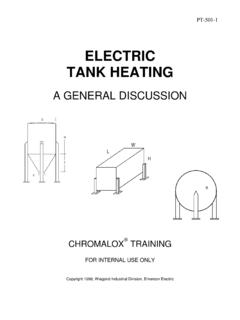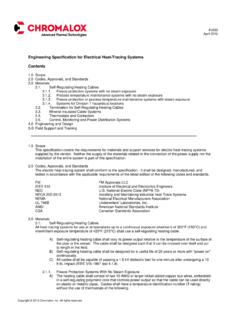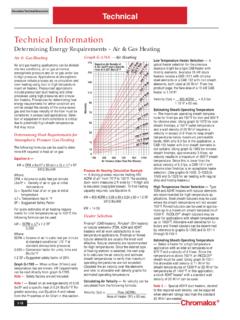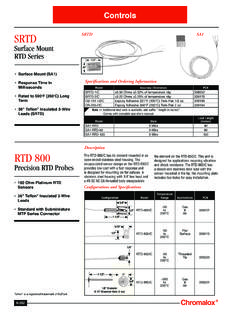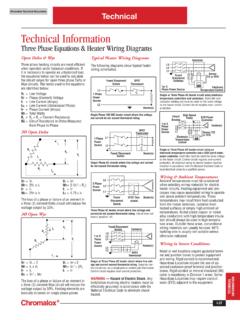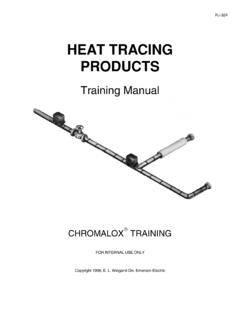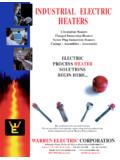Transcription of Chromalox Watt Density and Heater Selection
1 TechnicalI-13 TECHNICALINFORMATIONers or with tubular or strip heaters clamped to tank walls. The fi nal choice of Heater type will involve process considerations, appear-ance, available space both inside and outside, economy, maintenance, etc. The following pages cover the procedures for selecting heat-ers for clamp-on applications, liquid immer-sion heating, oil immersion heating, air or gas heating and cartridge or platen Heater ApplicationsThe limiting factor in most clamp-on Heater applications is the operating temperature of the Heater sheath.
2 Selecting heaters for clamp on applications requires an analysis of the maximum expected sheath temperature based on the estimated ambient temperature and the temperature of the material being heated. Graph G-175S provides a method of estimat-ing the sheath temperature and allowable watt densities for tubular heaters for various ambi-ent temperatures and wattage G-175S Clamp-OnTubular FEstimated Ambient Temp. ( F) (Sheath Temp. + Material Temp.)2 Technical InformationWatt Density & Heater Selection - GuidelinesUnderstanding Watt DensityWatt Density (W/in2) is the heat fl ux emanating from each square inch of the effective heating area (heated surface) of the = Rated Watts Effective heating areaThe effective heating area is the surface area per linear inch of the Heater multiplied by the heated length.
3 For strip heaters which are rectangular in shape, the surface area per linear inch is:1-1/2" wide = in2 per linear inch1" wide = in2 per heated length (HL) of strip heaters is calculated as follows:< 30-1/2" long HL = Overall Length less 4" 30-1/2" long HL = Overall Length less 5"For tubular elements, watt Density is deter-mined by the following heating area = x Dia. x Heated LengthThe surface area per linear inch of standard diameter tubular elements is shown below: Size (Dia.) In2/in. inch (1/4) inch (5/16) inch (3/8) inch (7/16) inch inch (1/2) following example illustrates the proce-dure for determining the watt Density of a typical tubular A 12 kW screw plug Heater has three " diameter elements with a B dimension of 32 inches and a 2 inch cold end.
4 The watt Density x x (32 in. - 2 in.) x 3 x 2 (Hairpin) = 268 in212,000 Watts 268 in2 - 45 W/in2 For convenience in selecting equipment, all heaters in this catalog have the watt Density specifi ed for standard Selection GuidelinesOnce the total heat energy requirements have been determined, the Selection of the type of electric Heater is based on three criteria. Maximum Sheath Temperature Sheath Material Recommended Maximum Watt DensityMaximum Sheath Temperature The sheath temperature of an electric element should be limited to prevent damage to the Heater and provide reasonable life.
5 To a large extent, the maximum sheath temperature of the heating element is determined by the fi nal operating temperature of the process. In direct immer-sion applications, the sheath temperature will approximate the temperature of the heated media. In clamp-on, air and gas heating ap-plications, the operating sheath temperature can be estimated using factors derived from empirical charts and Material Element sheath material is selected based on the maximum allowable sheath temperature, the material being heated and corrosion resistance required.
6 Depend-ing on the sheath material and construction, metal sheathed electric resistance elements will operate satisfactorily at temperatures from less than -300 F (cryogenic) to approximately 1500 F. Copper sheath elements are com-monly used for low temperature and direct immersion water heating. Steel is used for oil immersion and strip Heater applications. Stainless steel and INCOLOY are used for corrosive solutions, high-temperature gas or air heating and cartridge heaters. The table below lists the maximum recommended operating temperatures for common sheath materials (UL 1030):Copper 350 F Chrome Steel 1200 FIron 750 F Stainless 300 1200 FSteel 750 F INCOLOY 1600 F1 MONEL 900 F INCONEL 1700 F1 Maximum Recommended Watt Density Some materials such as water, vegetable oils and salt baths can tolerate relatively high sheath watt densities.
7 Other materials such as petroleum oils or sugar syrups require lower watt densities. These solutions have high vis-cosity and poor thermal conductivity. If the watt Density is too high, the material will carbonize or overheat, resulting in damage to the heating equipment or material being heated. Other sections of this catalog provide guidelines and suggestions for sheath materials and recom-mended watt densities for many common heating the values determined in the Selection criteria, choose the type of Heater best suited to the application.
8 For instance, water can be heated by direct immersion , circulation heat-403020100 Maximum Sheath (W/In2)0 200 400 600 800 1000 1200 1400 The example on the following page illustrates the procedure. 12 kW is required to heat mate-rial in a steel tank from 70 F to 800 F. Heat is to be supplied by tubular electric elements clamped to the side of the tank. Since the material is heated to 800 F, INCOLOY sheath elements must be 1 For sheath temperatures above 1500 F, contact your Local Chromalox Sales offi ce for application Use the Graph 1.
9 Select the maximum desired work temperature on Choose either chrome steel or rust- resistant iron sheath (points B) on the basis of operating Draw a straight line through points A and B to C. C gives the maximum allowable watts per square Select desired length Heater with equiva- lent or less watt Max. Work Temp. ( F)Chrome Steel SheathRust-Resistant Iron SheathABC 20 18 16 14 12 10 8 6 4 2 0 Max. W/In2 Strip Heater Selection Clamp-on ApplicationsEstimated Ambient Temp. ( F) (Sheath Temp.)
10 + Material Temp.)21200 F1100 F1000 F900 F800 F700 F600 F500 FSheathTemperatureSelecting Clamp-On TubularHeaters (cont d.)From the chart, a maximum sheath tempera-ture of 1200 F results in an average ambient temperature of (800 F + 1200 F) 2 = 1000 F. From the curves, the allowable watt Density is W/in2. Based on size of container, inch diameter TRI elements 28 in. long are TRI element has in2 per linear inch of sheath. The heated length is the overall sheath length less inches. The allowable wattage rating on the element is (28 - ) x x = 305 watts.
